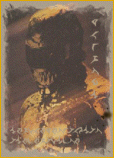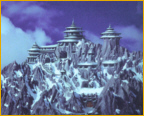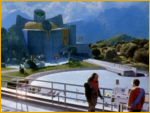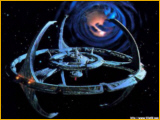Early Origins
Klingons are believed to have evolved on Qo'noS at roughly the same time as life began on Earth lightyears away. Some sources indicate that the Klingon race may be a few centuries older than humanity. This, along with the genetic compatibility between Klingons and humans, has led many to speculate that the Klingons were "seeded" along with various other races by the Preservers, an ancient race of humanoids who apparently mastered the genetic sciences.

Little is known about the early stages of life on Qo'noS, although some clues can be derived from a study of Klingon anatomy and physiology. Klingons are a very hardy and aggressive race, both physically and mentally. From this we can deduce that life on Qo'noS was likely harsh and survivalist - literally "survival of the fittest". Unfortunately, fossil records on the planet are not well-preserved, possibly due to the constant volcanic and seismic activity of the planet. However, in 2370, a mutagenic virus affected the crew of the Federation starship USS Enterprise-D, and resident Klingon Lt. Worf was "de-evolved" into a fearsome creature which only marginally resembled a modern Klingon. The morphology was captured by ship sensor systems, and is pictured above at left. The primitive Klingon shown featured an even more pronouced bone structure, but such is a discussion for anatomy, not history. At any rate, the Klingons evolved into an aggressive warrior race in which "might makes right".
Early Development
The first recognizable Klingon skeletons unearthed on Qo'noS are carbon-dated at around 500,000 BC, at which time Klingons appeared to dwell in tribal communities which roamed as they followed the migration of targ and other edible lifeforms. The first true city appears to have been constructed around 6000 BC by the warlord Kargas. The city still stands to this day, although it has been destroyed and rebuilt countless times. The concept of city-states was prevalent by 1000 BC, which apparently also saw large-scale warfare, as evidenced by the Battle of Tong Vey. During that incident, the city of Tong Vey was seiged by the warlord Sompek and his "sea of warriors". Actual evidence indicates a number closer to ten thousand.

The Coming of Kahless
By the century 850 AD, Qo'noS was ruled by a clan system of warlords and tyrants. Chief among these was a tyrant called Molor, who apparently ruled nearly a third of the habitable land mass. A soldier named Kahless (pictured at right) united the people against Molor, and began attacking the tyrant's strongholds. After nearly a decade of war, Kahless and his army laid seige to the final stronghold of Molor - a massive fortress located in the mountains near the Kri'Stak volcano. On the plains before the fortress, nearly fifty thousand warriors battled for more than a hundred days. Exact details are sketchy, but it would appear that Kahless' forces overcame and then stormed the fortress. Kahless himself killed Molor, and is said to have even created a special weapon with which to do it - the bat'leth, or "sword of honor" - which has since become a staple of Klingon culture.
The Birth of the Klingon Empire
After the defeat of Molor, the Klingon people united under a single banner with Kahless as the first Emperor. A capital city was established on the plains near Molor's defeat and was called Klinzhai after the sun which burned so fiercely during the day. Kahless united the people as never before and introduced many new ideas into Klingon culture. It was Kahless who began teaching the ways of honor and duty, instructing his people to savor life both in times of war as well as peace. Kahless reached an admirable age (approximately 150 years old) and disappeared from public view. Legend holds that he pointed towards a star and claimed he would return there before disappearing.
The Hur'Q Occupation

Nearly 700 years after the disappearance of Kahless, Qo'noS found itself at the cusp of industrial revolution. The population had been united for over 500 years and there had not been a major conflict for nearly as long. Quite unexpectedly, however, the planet was invaded by an alien race which the Klingons called the "Hur'Q" - the Klingon word for "outsider." The Hur'Q were large bipedal humanoids who possessed starship and energy weapon technology. They slaughtered the blade-wielding Klingons by the hundreds of thousands and occupied the planet for nearly two decades. Little is known about their appearance other than the fact that they were massively muscled and agile creatures. Popular myth describes them as having a large mouth full of sharp teeth and blades on the end of their hands. The only known rendition of a Hur'Q appears at left - a centuries-old tapestry drawn on animal hide.
Regardless of their appearance, the Hur'Q were savage occupiers. They looted the Klingon homeworld of nearly all treasures and many natural resources. It was not to last, however. The Klingons again united, this time against their invaders - a fearsome enemy against which they had no physical advantage. Using their natural savageness, they fought back against the Hur'Q for several years. Ultimately, it's unknown if the Hur'Q left of their own accord or were finally driven off. Either way, the Hur'Q remain in Klingon culture to this day as demons and monsters. Tales of the Hur'Q are used to frighten children, and even adult Klingons experience fear at the name.

The Warp Age
Using technology left behind by the Hur'Q, the Klingons began to understand physics and energy production at a level they would not have developed on their own for at least a century. After three decades of study and adaptation, the first Klingon starship left Qo'noS. Manned flight throughout their star system was widespread within another fifty years. Within the next two centuries, colonies were established on several other worlds, including Boreth - the only M-class planet in the star system which Kahless had pointed out almost 900 years prior. There on Boreth they established a monastery (pictured at right) and an order of monks whose sole purpose was to await the return of the first Emperor.
Other nearby planets and systems were colonized as well, spreading the Klingon Empire among the stars. During this period of expansion, the last Klingon Emperor died without an heir. The Klingon High Council, originally formed by Kahless himself as an advisory board, assumed the power vaccuum and has ruled ever since. The leader of the council, a position called the Chancellor, became the most powerful individual in the Empire. Another change brought about by the expansion was the ascendacy of Houses. Since non-warp travel took months or even years between colonies, and subspace communication had not yet been implemented, each colony had a family appointed as its caretakers and governors. These families, or "houses" as the Klingons call them, became very powerful and wealthy. This "house" system suited the Klingons and hearkened back to their days as a clan-based caste system. Before long, the High Council had a representative from each major house and many minor ones - a system which has endured to this day.
First Contact
In 2218, the Klingon Empire became aware of the United Federation of Planets. A Federation starship discovered Qo'noS and attempted to establish communication. The ship was never heard from again. Shortly thereafter, the Klingons began rapidly expanding their borders, now powered by warp-capable ships - undoubtedly the results of studying the Federation technology. Diplomatic relations between the two governments never reached maturity, and the Empire soon found itself at war with the Federation - a war that would last decades.
The Organian Peace Treaty
In the year 2267, the Klingon Empire attempted to expand into the Organian system, a strategically valuable sector near the Federation border. Feeling that the simple agrarian society native to Organia posed no threat, the Klingons had planned to ambush whatever UFP starship arrived. As they attempted to engage the arriving USS Enterprise, however, both ships were unable to use their weapons systems.

In reality, the Organians were a highly advanced race of non-coporeal beings who forced a peace between the UFP and Klingon Empire. Able to turn thought into reality, the immensely powerful Organians (seen at left) promised to disarm whichever side broke the treaty. Thus, after nearly 40 years, the Federation-Klingon war became a cold war - reduced to mutual mistrust and the occasional insult. With the constant threat of permanent disarmament, neither side risked the Organians' wrath, although there was more than one close call. The forced peace would last nearly three decades, until the destruction of Praxis in 2293 brought about a permanent alliance between the two powers. Ironically, years later it was discovered that the Organians had disappeared from the galaxy less than a decade after their mandate. Merely the threat of their intervention had been enough to keep war at bay and lay a foundation for peace.
The Romulan-Klingon Alliance
No longer able to focus their aggressive tendecies on the Federation, the Klingons then turned their eye towards their other neighbor, the Romulan Star Empire. The Klingons first allied themselves with the Romulans, hoping that such an alliance might allow them to destroy the Federation or even the Organians. However, the Klingons found that their new allies had little to offer, and the honorable Klingons found themselves at odds with the Romulan values of subterfuge and stealth. Several technologies were shared between the two, including cloaking devices and disruptor weaponry. Eventually the two disputed over a mineral-rich moon, and the Romulans attempted to take the planetoid by force. Feeling themselves betrayed, the Klingons sent a massive fleet directly into Romulan space and laid siege to Romulus itself. Having proved their point and lacking the resources to uphold sustained combat, the fleet withdrew. The Romulans no longer attempted military action against the Klingons, but later events proved that they were only biding their time. The Klingons, however, had other things to occupy their time.
The Cardassian-Klingon War
In 2286, a series of border skirmishes erupted into full-scale conflict between the Klingon Empire and the Cardassian Union - another neighbor of the Klingons. The conflict lasted for eighteen years, until the Klingon High Council declared the war a victory in 2304. The conflict's latter years had consisted mainly of minor skirmishes. The Cardassians had been soundly beaten during the first decade, but the Klingons wanted to make sure their enemies understood who held the upper hand. The Klingons were forced to turn their attention away from the Cardassians in 2292 when the Romulans expelled all Klingon ships from their territory. Klingon intelligence then discovered that the Romulans had been building for war while the Empire fought the Cardassians. It appeared yet again that war was imminent.

The Khitomer Accords
In 2293, an event happened that changed the Klingon Empire forever. Because of the military buildup against the Romulans, the Klingons had been taxing their industry to nearly critical levels for over a year. Their primary power facility, located deep within the Qo'noS moon Praxis, experienced cascade failure and exploded in a multi-megaton flare. The event left over half of the moon vaporized and the Klingon homeworld with a devastating environmental disaster. With no resources to combat this unforeseen threat, it was determined that the Klingon Empire had no more than fifty years left in it. The war with the Romulans was forgotten, and the Romulans seemed content to sit back and watch their former allies suffer. The Federation, however, was not. Federation peacekeepers immediately met with members of the Klingon High Council and an alliance was formed in which the UFP provided the Empire with assistance in exchange for continued peace. The treaty was called the Khitomer Accords (due to the fact that it was signed on the planet Khitomer, above) and lasted until the Dominon War in 2372.
The Romulan-Klingon War
By 2344, the Klingon homeworld had been stabilized thanks to Federation aid. The Empire had been at relative peace for the past four decades, but it was not to last. The Romulans had finally decided it was time to strike and they did so - quite violently. The first incident saw the outpost on Narendra III destroyed by no less than four Romulan warbirds. The attack also resulted in the destruction of the USS Enterprise-C, a Federation starship which rushed to the outpost's aid. After that, the Romulans attacked colonies on Khitomer and Edosha VII. In all three cases, the colonies were aided by Federation personnel - a fact which highly impressed the Klingons. The Klingons retaliated against the Romulans, and the brief series of skirmishes are now called the Romulan-Klingon war. To repay the Federation for their intervention, a formal Treaty of Alliance was signed between the two governments on Narenda III. Facing the possibility of war with both the Klingon Empire and the Federation, the Romulans withdrew all ships back into their territory and were not heard from again for nearly twenty years.
Klingon Civil War
The Empire experienced relative peace until 2367. The Empire was skillfully led by Km'pec, who held the seat of Chancellor longer than anyone in history, until he was dishonorably poisoned - apparently by Duras, one of the two contenders for the position. When the USS Enterprise's Lt. Worf killed Duras, the other candidate - Gowron - won by default. Less than a year after assuming power, Gowron found himself challenged by Toral, the illegitimate son of Duras, and his two aunts - Lursa and Be'tor (pictured below).

When Gowron refused to step down in favor of the teenage Toral, the Empire found itself in a brief but damaging civil war between the two factions. The Empire was again aided by the Federation, who exposed an alliance between the Duras family and the Romulans. The conflict, however, had left Gowron extremely paranoid regarding his position - a paranoia that would eventually bring the Empire to near ruin.
The Return of Kahless
Having experienced some sort of major conflict every fifty years or less for the past few centuries had taken its toll on the Klingon people. Sensing that the spirit of their people was in danger, the monks of Boreth took it upon themselves to clone the original Kahless from blood left on an ancient dagger. The resulting clone had many of the memories of the original, due to genetic imprinting, and represented a symbol of a bygone era. Gowron and many of the High Council saw the new Kahless as a threat to their power, and immediately called for his destruction. However, a compromise was reached wherein Kahless would again become Emperor, but only in a limited monarchy. The council would retain the political and law-making power, but the newly-appointed Emperor would act as a spiritual advisor for his people - a rallying point of sorts. The plan worked well, and the Klingon people enthusiastically greeted their new Kahless. He has since spent his days attempting to restore some sense of purpose to the Klingons, and only time may tell if he is successful.
The Dominion War
In 2371, Federation scouts used the Bajoran wormhole to enter the Gamma Quadrant and perform reconnaissance. They were met on the other side by the Dominion, an empire native to the Gamma Quadrant. Initial contact between the two quadrants went poorly, and tensions mounted. The leaders of the Dominion were a race of shape-shifters who call themselves "changelings" and used their ability to sow mistrust and discord among their enemies. In 2372, the government of Cardassia was overthrown and Gowron became convinced that the Union had been overtaken by the Dominion.

He led a massive fleet of Klingon ships in an invasion of Cardassia Prime - an invasion which was publicly criticized by the Federation. When the UFP then harbored the fugitive ruling body of Cardassia (called the Detapa Council), Gowron and the fleet laid siege to Deep Space Nine, the station where the Council was being held (seen at right). The commander of the station, Captain Benjamin Sisko, convinced Gowron that the Klingons and Federation fighting amongst themselves only served to strengthen their mutual enemy - the Dominion. Gowron relented his attack, but withdrew the Klingon Empire from both the Khitomer Accords and the Treaty of Alliance.
A Return to Honor
When a Federation covert mission discovered that Gowron's top military adviser, General Martok, was in fact a Changeling, the incident convinced Gowron to reinstate relations with the Federation. The Klingon Empire re-joined the Khitomer Accords and Gowron signed a new Treaty of Alliance. The real Martok (pictured below) was later rescued from a Dominion prison camp and shortly thereafter placed in command of the Klingon war effort. A commoner who had achieved his position through hard work and valor in battle, Martok became very popular with the soldiers under his command. Too popular, in fact - Gowron soon felt threatened by Martok, and the Chancellor himself began to lead the war effort.

Unfortunately, Gowron's skills as a general were somewhat less than his skills as a politician, and his leadership in battle lead to several embarassing and needless defeats for the Klingon fleet. Martok was urged by many to challenge Gowron for his position as Chancellor, but Martok was loyal to the Empire and would not. Instead, Gowron was challeged by Worf, now a Lieutenant Commander stationed on Deep Space Nine and an adopted member of Martok's family. Worf was victorious and was expected to assume the role of Chancellor, but he instead appointed Martok to the position. Martok was reluctant in his acceptance of the seat, but he rose to lead the Klingons and their allies (the Federation and Romulans) to a great victory over the Dominion. True to a vow he had made earlier, the new Chancellor stood among the ruins of Cardassia Prime and drank a bloodwine toast to his people's victory. Thus begins the legend of Chancellor Martok - the man who would eventually lead the Klingon Empire into a new period of expansion and inner discovery not seen since the reign of Kahless.
The history of the Klingon people is still being written, as new legends and dramas unfold with each passing day. They are one of the cornerstones of the Star Trek universe, and will forever be part of its rich tapestry.


